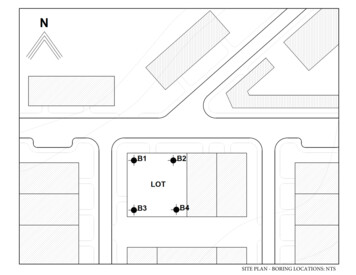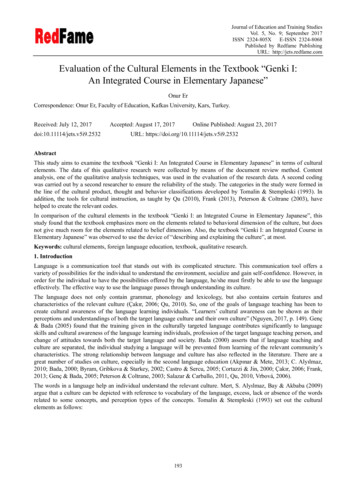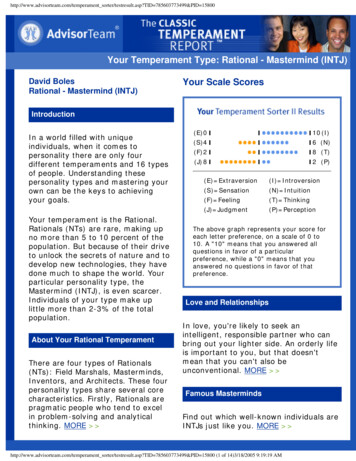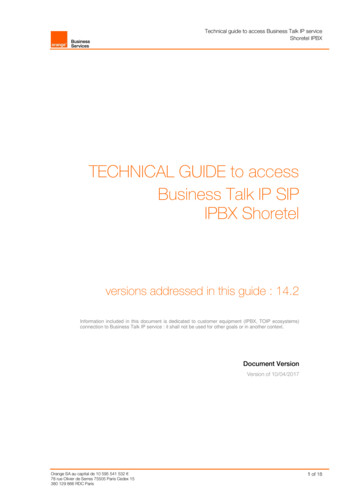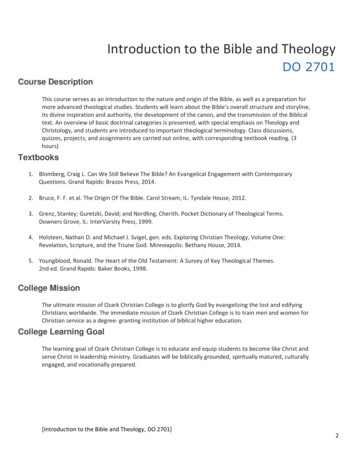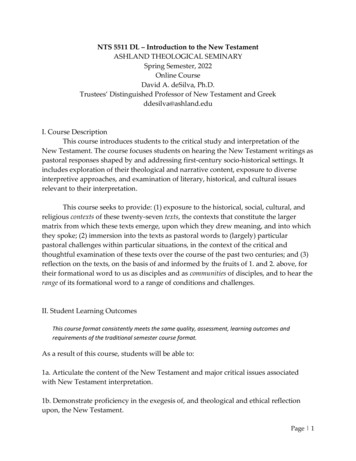
Transcription
NTS 5511 DL – Introduction to the New TestamentASHLAND THEOLOGICAL SEMINARYSpring Semester, 2022Online CourseDavid A. deSilva, Ph.D.Trustees’ Distinguished Professor of New Testament and Greekddesilva@ashland.eduI. Course DescriptionThis course introduces students to the critical study and interpretation of theNew Testament. The course focuses students on hearing the New Testament writings aspastoral responses shaped by and addressing first-century socio-historical settings. Itincludes exploration of their theological and narrative content, exposure to diverseinterpretive approaches, and examination of literary, historical, and cultural issuesrelevant to their interpretation.This course seeks to provide: (1) exposure to the historical, social, cultural, andreligious contexts of these twenty-seven texts, the contexts that constitute the largermatrix from which these texts emerge, upon which they drew meaning, and into whichthey spoke; (2) immersion into the texts as pastoral words to (largely) particularpastoral challenges within particular situations, in the context of the critical andthoughtful examination of these texts over the course of the past two centuries; and (3)reflection on the texts, on the basis of and informed by the fruits of 1. and 2. above, fortheir formational word to us as disciples and as communities of disciples, and to hear therange of its formational word to a range of conditions and challenges.II. Student Learning OutcomesThis course format consistently meets the same quality, assessment, learning outcomes andrequirements of the traditional semester course format.As a result of this course, students will be able to:1a. Articulate the content of the New Testament and major critical issues associatedwith New Testament interpretation.1b. Demonstrate proficiency in the exegesis of, and theological and ethical reflectionupon, the New Testament.Page 1
[2. Not assessed in this course.]3. Identify (a.) the limits of their own cultural and social location upon their reading andinterpreting the New Testament and (b.) strategies to compensate for the same for thesake of a richer engagement with the New Testament and its formational challenges.[4.-6. Not assessed in this course.]III. Course RequirementsA. Textbooks and Other Materials1. D. A. deSilva, An Introduction to the New Testament: Contexts, Methods and MinistryFormation (2nd edition; Downers Grove, IL: InterVarsity Press, 2018). ISBN-10:0830852174; ISBN-13: 978-0830852178.2. A modern English translation of the New Testament, preferably the New RevisedStandard Version (NRSV), New International Version (NIV 2011), or English StandardVersion (ESV).Participants will also read a variety of articles or essays written from a broad array ofideological and global locations as well as some supplementary material by theinstructor. These will all be available within the online course shell in .pdf format.B. Assignments/Assessment of Student Learning1. Online EngagementOnline courses require that students take a more active stance in regard toattaining the learning outcomes for the course as well as contribute to one another’sattainment of the same. Pay close attention throughout the course to the various facetsof each week’s venues for engagement of the material, both “passive” (e.g., viewinglectures) and “active” (e.g., engaging in the various discussion forums), and investyourself fully not only for the sake of your own learning and processing, but also for thesake of your peers’ learning and processing.Weekly posts and responsesPage 2
Each week, each of you will create a post containing a substantial paragraph on each ofthe following: (1) what most stimulated their fresh thinking about the particular NewTestament text or other concepts studied this week and the formative impact of thesame on your vision for discipleship and ministry in your context; (2) what mostdisturbed you about the material you encountered this week, and why; (3) what willrequire further thought, research, and/or conversation to process fully (also, whatquestions, if any, do you have about the material you’ve read or heard that week).These are simply essential questions students ought to ask of themselves every week inevery class, so as to clearly and intentionally process their ongoing learning experiencesand identify their own “take-aways” that make the experience one of lasting value andimpact. If you keep notes with a view to these topics as you read, creating your postswill be fairly easy to do at the end of each week.Each week, each of you should also respond to two of your peers, particularly in regardto items #2 and #3. Plan to respond thoughtfully and constructively (not “Goodthoughts!” “I agree!” “That bugs me, too!”). The point of this exercise is to help you allprocess the material in ways that are particularly relevant to you and your ownformational journey and ministry context, as well as to find out where the stumblingblocks are for you and try together to help one another navigate these.PLEASE ALSO KEEP YOUR OWN POSTS (not your responses to your peers’ posts, butthe primary posts you make) IN A WORD DOCUMENT, akin to a journal, FORSUBMISSION AT THE END OF THE SEMESTER! I’ll read and respond to postsweekly just like everyone else, but I also find it helpful to see these all in a glance at theend as I try to recall the depth of each student’s engagement with the material week byweek.A word about how online discussion forums will work:These will be largely retrospective. By the end of Week One (for example), you will postyour own responses to the above in regard to the Week One material, but on Mondayand Tuesday of Week Two – while we are also pursuing our largely individual grasp ofthe new material for that week (doing the new readings, viewing the new videos) – wewill discuss (that is, we will all post our responses to) the posted materials from WeekOne (and so forth each successive week). It just hasn’t worked to try to cram posts andresponses on a given week’s material into that same week.There will be a second forum in which students will participate in Weeks Two andThree involving specific assignments tied to the week’s material.2. Midterm and Final Essay ExaminationsPage 3
These instruments will determine to what extent the student has digested thecourse material and internalized the more essential content matter of the course. Asuccessful examination will reflect close engagement with my textbook and the NewTestament texts themselves and will address all points of each exam question in anorganized fashion. I like success more than surprises, so these exams will be distributedearly so that you can use them as “filters” for study and gathering notes and thus workon them as you go through the whole course. Please note: students who havefollowed these directions have most frequently been happiest with my evaluations oftheir exams.You are welcome (but by no means required) to collaborate with one another instudy groups and the like (that you all will undertake to organize, or not) if you believethis would help you arrive at optimal answers to these essays. This applies tointerpreting the questions together and uncovering material that will lead to successfulanswers, not to formulating the answers/essays themselves (i.e., write up your ownanswers).3. Exegetical PaperIn order to practice and demonstrate his or her growing facility in the process ofexegesis, each student will write an exegesis paper on a discrete unit of the text (thesewill generally fall between five and ten verses in length).The many sections in the principal textbook, An Introduction to the New Testament,entitled “Exegetical Skills” provide a primary resource for thinking about a wide arrayof investigative lenses, typically offering models of their application that can guide youas you bring these questions to your own passage. Another very useful resource is the“ATS Model of Exegesis,” a document available from the seminary web site thatrepresents a kind of consensus model developed by the entire biblical studiesdepartment. This is a model for investigation, not an outline for presentation.You should select a passage to study from the list below by the end of week 3. Itwould be greatly to your advantage, then, to use these “Exegetical Skills” sections toexplore/investigate your passage week-by-week through the various lenses andapproaches described (to the extent appropriate – not every passage lends itself to every“skill”). You should also begin to read through what three critical commentaries (seebelow) have to say about your passage, as these commentators will themselves haveengaged the passage from the vantage point of several, and perhaps many, of theseexegetical skills.The paper should fall between 12 and 15 double-spaced pages (at 12-point type)and use a standard method of referencing (in-text references with works cited list orstandard footnotes). The paper will be evaluated on the basis of how well the student:Page 4
a. shows evidence of having worked through the discrete questions and skills laid outand demonstrated in the “Exegetical Skills” sections of my textbook, as called for by thepassage chosen (not every passage yields fruit to every “exegetical skill”);b. engages appropriate secondary literature in the process of discovery and synthesis ofthose questions and approaches;c. presents his or her reading of the passage in clearly written, logically coherent prose;andd. discovers an organic connection between the work done in the exegesis of thepassage and the application of the text to Christian discipleship and ministry anddevelops the latter.In regard to “appropriate secondary literature,” your exegesis paper must showevidence of close interaction with at least three critical commentaries (such as are listedbelow) and three other academic sources (journal articles, scholarly books andmonographs, entries from substantial bible dictionaries like the Anchor Bible Dictionary,the New Interpreter’s Dictionary of the Bible, or the IVP Dictionary of Jesus and the Gospelsand Dictionary of New Testament Background). A “critical” commentary is one that seeksto lead out the meaning of the text under investigation fully in the light oflinguistic/lexical, literary, historical, philosophical, tradition-historical, and culturalcontexts. They are therefore valuable resources for answering many of the questionsfound in the “ATS Model of Exegesis.” The following series provide excellent examplesof what I have in mind: Word Biblical Commentary (WBC), New International GreekTestament Commentary (NIGTC), New International Commentary on the NewTestament (NICNT), Anchor Bible Commentary (AB), Baker Exegetical Commentary onthe New Testament (BECNT). Many other commentaries would fit the bill (e.g., RobertGundry’s on Mark and Matthew, Craig Keener’s on Matthew and John). The coursetextbook, An Introduction to the New Testament, provides an up-to-date (2018!) startingplace for additional sources. Recent critical commentaries are also excellent places tolook for bibliographic information. I am available for consultation on resources as well(and I strongly advise that you do check in with me about this).The following are my recommendations for passages for your paper (just to be clear, thesemi-cola separate possible choices within a particular book):Matthew 5:38-48; 12:1-8; 15:1-20; 21:33-44; or 22:1-14Mark 9:2-13; 10:1-12; 11:12-26; 12:18-27; or 12:28-34Luke 4:1-13; 4:14-30; 14:12-24; 22:14-27Page 5
John 5:1-18 or 12:12-19Acts 3:11-26; 8:26-40; 15:1-21; or 17:22-31Romans 15:1-131 Corinthians 1:18-31; 10:1-13; or 11:17-342 Corinthians 3:7-18Galatians 2:15-21; 4:21-31; or 5:1-6Philippians 2:1-11Colossians 1:9-23 (with a focus on 1:15-20)Hebrews 6:4-12; 10:19-31; 10:32-39; or 12:1-11James 2:14-26 or 4:1-101 Peter 2:1-10 or 4:12-19Revelation 2:18-29; 4:1-11; or 14:6-13If you have a particularly strong desire to focus on a different passage, consult with mefirst – and earlier than week 3! If I feel that the passage will allow you to exercise asufficiently full range of exegetical skills, I may accept it as an alternative.C. Calculation of Grade and Connection of Learning OutcomesAssignmentsOnline EngagementMidterm Exam (due 3/11)Final Exam (due 5/5)Exegesis Paper (due 5/5)Learning Outcomes1a, 31a1a1b, 3Percent of Final Grade25252525IV. Course ScheduleThe following table lays out our tentative schedule. Reading the actual text of the NewTestament is an essential part of this course, even if you consider yourself to be highlyfamiliar with its contents. In the best-case scenario, you would read the text once in onetranslation prior to reading the textbook, and a second time in a second translation afterreading the textbook. I recognize that two readings will not always be possible,especially with the longer NT books – but never omit a first fresh, thoughtful readingthrough of the NT book before digging into the textbook and other materials.Page 6
icThe WorldBetween theTestamentsThe Social andCultural Worldof the NewTestamentFour Gospels,One JesusReadings/AssignmentsdeSilva, Introduction, 1-81;Videos on history from Alexander to Hadrian;Video on the Apocrypha (general introduction);Online discussion forumOptional resources: lectures 2-8 on the ApocryphadeSilva, Introduction, 82-116;deSilva, “We Are Debtors” (.pdf);deSilva, “Jews in the Diaspora” (.pdf);Video on Roman Imperial Ideology;Online Special Forum on “Grace” in its FirstCentury ContextOnline discussion forum (See III.C.1.B above)Optional resources: Videos on Honor, Patronage,Kinship, and PuritydeSilva, Introduction, 117-173;deSilva, “Sample Assessments of JesusTraditions” (.pdf);Online Exercise on Gospels and HistoryThurman, “Jesus – An Interpretation” and“Love”;Online discussion forumOptional resources: deSilva, Jewish Teachers of Jesus,14-30 (.pdf)(continued)41/31-2/6Mark’s GospelSelect your exegesis paper passage by the end ofthis week and obtain three critical commentarieson that book (see assignment description insyllabus for details)The Gospel of Mark;deSilva, Introduction, 174-209;deSilva, Jewish Teachers of Jesus, 158-174 (.pdf);Powery, “Mark,” from True to Our Native Land;Videos: Capernaum; The Gospel of Mark in theShadow of Rome;Online discussion forumPage 7
52/7-2/13Matthew’sGospelThe Gospel of Matthew;deSilva, Introduction, 210-260;Levine, “Discharging Responsibility: MattheanJesus, Biblical Law, and Hemorrhaging Women”;Video: Jesus and Ben Sira;Online discussion forum62/14-2/20Luke’s GospelThe Gospel of Luke;deSilva, Introduction, 261-303;Reimer, “The Forgiveness of Debts in Matthewand Luke: For an Economy without Exclusions”;Videos: “Luke’s Infancy Narrative and ImperialIdeology”; “When You See Jerusalem SurroundedBy Armies”;Online discussion forum72/21-2/27John’s GospelandCommunitiesThe Gospel of John; 1-3 John;deSilva, Introduction, 341-408;Katanacho, “Reading the Gospel of John ThroughPalestinian Eyes”;Online discussion forum82/28-3/6Introduction toPaul; ActsThe Acts of the Apostles;deSilva, Introduction, 409-426, 304-340;Keener, “Anticipating Ancient AfricanChristianity”;(continued)Online discussion forum93/14-3/20MIDTERMEXAM DUEFriday, 3/11, at9am!Galatians andRomansOptional: Video on Athens and Paul’s VisitPaul’s Letters to Galatia and Rome;deSilva, Introduction, 427-460, 526-564;deSilva, “Neither Tamil Nor Sinhalese: ReadingGalatians with Sri Lankan Christians”;Videos: Transformation as the Heart of Paul’sGospel (all parts); Rome; Pisidian Antioch;Online discussion forumPage 8
103/21-3/271&2Thessalonians; 1& 2 CorinthiansPaul’s Letters to Thessalonica and Corinth;deSilva, Introduction, 461-525;Tamez, Lumbala, and Arichea, “1 Corinthians15:1-58”orSecrest, “Identity and the Embodiment ofPrivilege in Corinth”;Videos: Paul’s Corinth; ThessalonicaOnline discussion forum113/28-4/3Paul’s PrisonEpistles124/4-4/10The Pastorals;Letter to theHebrewsPaul’s Letters to Philippi, Philemon, Ephesus, andColossae;deSilva, Introduction, 565-648;Adewuye, “Reading Ephesians 6:10-18 in theLight of African Pentecostal Spirituality”;Lewis, “An African American Appraisal of thePhilemon-Paul-Onesimus Triangle”;Videos: Philippi; Ephesus; Wisdom’s New Face;Online discussion forumPaul’s Letters to Timothy and Titus; The Letter tothe Hebrews;deSilva, Introduction, 649-719;Videos on Hebrews and Patronage; Hebrews andPurity;Online discussion forum134/11-4/17HOLY WEEK144/18-4/24James, Peter,JudeIn honor of Holy Week, I’m giving you the wholeweek to make sure you’re all caught up and,alongside your church duties, to Work on final exams and exegetical papers!James, 1 & 2 Peter, Jude;deSilva, Introduction, 720-785;Tamez, “James”;deSilva, “Reading 1 Peter in Sri Lanka”;Videos on 1 Peter and Honor; 1 Peter andKinship; James and Ben Sira;Online discussion forumWork on final exams and exegetical papers!Page 9
15164/25-5/15/2-5/5Revelation;Formation of theNew Testament“EXAM WEEK”The Revelation of John;deSilva, Introduction, 786-830;Blount, “The Witness of Active Resistance: TheEthics of Revelation in African AmericanPerspective”;Videos: Revelation and Roman Imperial Ideology(parts 1-3);Online discussion forum (focus on Revelation);Patzia, Making of the New Testament, 166-191(.pdf);“Canonical Formation of the New Testament”(from Dictionary of New Testament Background)Work on final exams and exegetical papers!EXAMS, PAPERS, and JOURNALS are due by5pm on Thursday, May 5. NO late work will beaccepted without prior, successful appeal for anincomplete or, in extreme circumstances,extension.V. Recommendations for Lifelong Learning1. Select a second introduction to the New Testament, particularly one written from adifferent theological location, and put it into critical dialogue with my own. Suggestionswould include: R. E. Brown, An Introduction to the New Testament (New York:Doubleday, and New Haven: Yale University Press, 1997); M. E. Boring, An Introductionto the New Testament: History, Literature, Theology (Louisville: Westminster John KnoxPress, 2012); B. D. Ehrman, The New Testament: A Historical Introduction to the EarlyChristian Writings (5th ed.; New York: Oxford University Press, 2011); C. R. Holladay, ACritical Introduction to the New Testament (Nashville: Abingdon, 2005). Whatarguments/positions seem stronger? Where will you finally come down on points ofhistorical setting, composition, and meaning?2. Pursue more in-depth study of particular New Testament books in their historical,cultural, and theological contexts by taking upper-level courses on particular texts (e.g.,Luke, Romans, Galatians, Thessalonian Letters, Hebrews, or Revelation) and contexts(e.g., “New Testament Backgrounds” or “Life and Literature Between the Testaments”).Page 10
3. Create a reading plan for working through the most salient Jewish and Greco-Romanliterature of the Hellenistic and Roman periods to enrich your understanding of thesocio-political and cultural world within which the early Christian movement tookshape and by which it was deeply formed. The suggestions for further reading at theend of INT, chapter 2, will help you in this endeavor.4. Read more in-depth studies on individual New Testament books and figures (e.g.,Jesus, Paul, James) to take your knowledge to the next level beyond this briefintroduction.5. Teach or preach through several books of the New Testament, interacting in yourpreparation with what you have learned in this course as well as several of thesuggestions for further reading at the end of the appropriate chapters in INT.VI. Selected Bibliography or ReferencesSuggestions for further reading/bibliography can be found at the end of every chapterin INT. Other important bibliographic resources would include the main bibliographiesand sectional bibliographies in the individual volumes of the Word Biblical Commentaryas well as the main bibliographies in the individual volumes of the New InternationalCommentary on the New Testament and New International Greek Testament Commentary.Full bibliographic entries for the additional weekly readings are as follows:J. Ayodeji Adewuye, “Reading Ephesians 6:10-18 in the Light of African PentecostalSpirituality,” pp. 83-94 in Global Readings: Reading the Bible in the Majority World (ed.Craig Keener and M. Daniel Carroll R.; Peabody, MA: Hendrickson Publishers, 2013).Brian K. Blount, “The Witness of Active Resistance: The Ethics of Revelation in AfricanAmerican Perspective,” pp. 28-46 in From Every People and Nation (ed. David Rhoads;Minneapolis: Fortress Press, 2005).David A. deSilva, The Jewish Teachers of Jesus, James, and Jude: What EarliestChristianity Learned from the Apocrypha and Pseudepigrapha (Oxford and New York:Oxford University Press, 2012)., “Jews in the Diaspora,” pp. 272-290 in Joel B. Green and Lee M. McDonald,eds. The World of the New Testament: Cultural, Social, and Historical Contexts (GrandRapids: Baker Academic, 2013)., “Reading 1 Peter in Sri Lanka,” in Mariam Kamell Kovalishyn, ed., ReadingScripture with the Majority World (Grand Rapids: Baker Academic, forthcoming).Page 11
, “Neither Tamil Nor Sinhalese: Reading Galatians with Sri LankanChristians,” pp. 39-56 in Global Readings: Reading the Bible in the Majority World (ed. CraigKeener and M. Daniel Carroll R.; Peabody, MA: Hendrickson Publishers, 2013)., “‘We Are Debtors’: Grace and Obligation in Paul and Seneca,” pp. 150-178in Joseph Dodson and David Briones, eds., Paul and Seneca in Dialogue (Leiden: Brill,2017).Yohanna Katanacho, “Reading the Gospel of John Through Palestinian Eyes,” in GeneL. Green, Stephen T. Pardue, and K. K. Yeo, eds., Majority World Theology: ChristianDoctrine in Global Context (Downers Grove: InterVarsity, 2020).Craig Keener, “Anticipating Ancient African Christianity,” pp. 274-282 in BetweenHistory and Spirit: The Apostolic Witness of the Book of Acts (Eugene, OR: Cascade, 2020).Amy-Jill Levine, “Discharging Responsibility: Matthean Jesus, Biblical Law, andHemorrhaging Woman,” pp. 70-87 in A Feminist Companion to Matthew (ed. Amy-JillLevine; Sheffield: Sheffield University Press, 2001).Lloyd A. Lewis, “An African American Appraisal of the Philemon-Paul-OnesimusTriangle,” pp. 232-246 in Stony the Road We Trod: African American Biblical Interpretation(ed. Cain Hope Felder; Minneapolis: Fortress Press, 1991).Arthur B. Patzia, The Making of the New Testament: Origin, Collection, Text & Canon(2nd ed.; Downers Grove: InterVarsity, 2011).Emerson B. Powery, “Mark,” pp. 121-157 in True to Our Native Land: An AfricanAmerican New Testament Commentary (ed. Brian K. Blount; Minneapolis: Fortress, 2007).Ivoni Richter Reimer, “The Forgiveness of Debts in Matthew and Luke: For an Economywithout Exclusions,” pp. 142-157 in R. S. Sugirtharajah, ed., Voices from the Margin:Interpreting the Bible in the Third World (3rd ed.; New York: Orbis, 2006).Love L. Secrest, “Identity and the Embodiment of Privilege in Corinth,” pp. 9-30 inYung Suk Kim, ed., 1 and 2 Corinthians (Texts @ Contexts; Minneapolis: Fortress Press,2013).Elsa Tamez, “James,” pp. 381-391 in Elisabeth Schüssler Fiorenza, ed., Searching theScriptures: A Feminist Companion (New York: Crossroad, 1994).Elsa Tamez, Francois Kabasele Lumbala, and Daniel C. Arichea, “1 Corinthians 15:158,” pp. 185-200 in John R. Levison and Priscilla Pope-Levison, eds., Return to Babel:Global Perspectives on the Bible (Louisville: Westminster John Knox Press, 1999).Howard Thurman, “Jesus – An Interpretation,” pp. 11-35 in Jesus and the Disinherited(Boston: Beacon Press, 1976).VII. Seminary GuidelinesA. ATS Academic Integrity PolicyAshland Theological Seminary expects each student to uphold the Seminary’s corevalue of academic excellence by contributing to an environment that is both challengingPage 12
and supportive. In such an environment a student will neither seek nor offer improperassistance. All students have an obligation to be forthright in their academic endeavorsand to respect ethical standards. The work that one submits for academic evaluationmust be one’s own, unless an instructor expressly permits certain types of collaboration.Academic integrity requires that each student will use one’s own capabilities to achieveone’s fullest potential and will neither offer nor accept aid that is not in keeping withregularly accepted standards of academic integrity. Failure to conform to this conductshall constitute academic dishonesty. The full Academic Integrity Policy statement maybe found in the Student Handbook.B. ATS Grading ScaleGrade QualityA4.0Percent97-100AB B3.73.33.092-9689-9186-88BC C2.72.32.083-8580-8277-79CD rior achievement of course objectives, diligenceand originality, high degree of freedom from error,outstanding evidence of ability to utilize courseknowledge, initiative expressed in preparing andcompleting assignments, positive contributionsverbalized in class.Good work submitted, commendable achievementof course objectives, some aspects of the course metwith excellence, substantial evidence of ability toutilize course material, positive contributionsverbalized in class, consistency and thoroughness ofwork completed.Acceptable work completed, satisfactoryachievement of course objectives, demonstrating atleast some ability to utilize course knowledge,satisfactory class contribution.Passing but minimal work, marginal achievementof course objectives, poor performance incomprehension of work submitted, inadequate classcontributions.Page 13
F0.0Below 65Unacceptable work resulting in failure to receiveclass credit, inadequacy of work submitted or ofperformance and attendance in class.C. AttendanceAccording to the Student Handbook, attendance at all class sessions is expected, unlessthe professor has been notified in advance and has approved the absence. Studentsshould be on time and should stay through the duration of all classes. Any studentmissing more than six class hours will be required to do additional work, receive alower grade, audit or withdraw from the class, or be penalized otherwise at thediscretion of the professor.In an online course, “attendance” translates into “diligent engagement of the week’slectures, group work, discussion forums, and other venues for attaining the learningoutcomes” each week.D. Attendance Reporting:Students are required to participate in a course related activity in the first and thirdweeks of the course. Students may be administratively withdrawn from the courseand/or may lose financial aid benefits if a qualifying activity has not occurred betweenthe student and the course work or faculty within the first three days of the course.Simply logging into a course online via the Learning Management System (LMS) is notconsidered a qualifying activity.Student non-participation during the first 8 days of a course may initiate theadministrative course withdrawal process. Student non-participation, mid-course, for14 consecutive days may also initiate the administrative course withdrawal process.According to policies and procedures set forth by Ashland University’s Department forVeterans’ Services, AU will grant any service member requiring more than a 30-dayleave a release from coursework. Contact the Office of Veterans’ Services for moreinformation regarding this process.E. Accessibility Resources and AccommodationsIt is Ashland University’s goal that learning experiences be as accessible as possible. Ifyou anticipate or experience physical or academic barriers based on a disability, pleasecontact the Student Accessibility Center at 419-289-5904, or send an email to ausac@ashland.edu. The Student Accessibility Center office and the course instructor willwork together in order to establish accommodations and to meet your learning needs.F. Writing and Communication Center (WCC)Page 14
The Writing and Communication Center can help you brainstorm, draft, andrevise your writing assignments in your graduate Seminary classes. Mastersand doctoral qualified consultants can advise you online or in person. For moreinformation click here. Receive one-on-one feedback from an WCC graduate consultant on any projectthat involves communication - essays, speeches, group presentations, lab reports,poster presentations, and much more! Our default type of appointment for graduate students is conductedasynchronously via email. In other words, after you make an appointmentthrough our online scheduler (WCOnline), you attach a draft to the appointment,then within 48 hours of the scheduled appointment, one of our consultantsreviews your paper and emails you feedback. We also offer synchronous (live)appointments via Zoom by request. To schedule an asynchronous email appointment, go towww.ashland.mywconline.com (you will need to register for an account the firsttime you use the scheduler). To schedule a synchronous (live) Zoom appointment, please email us atamulitcenter@ashland.edu.Visit our graduate services webpage for more information ts/graduate-writing-consultationPage 15
NTS 5511 DL – Introduction to the New Testament ASHLAND THEOLOGICAL SEMINARY Spring Semester, 2022 Online Course David A. deSilva, Ph.D. Trustees’ Distinguished Professor of New Testament and Greek ddesilva@ashland.edu I. Course Description This course introduces students to the critical study
